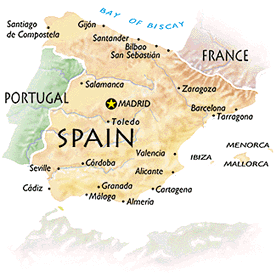
 Stay in a Castilian castle, explore
the Plain of La Mancha or discover Madrid's vast store of art. Whether your appetite is
for palaces or tapas bars, museums or mountain climbing, Spain is famously fabulous.
Stay in a Castilian castle, explore
the Plain of La Mancha or discover Madrid's vast store of art. Whether your appetite is
for palaces or tapas bars, museums or mountain climbing, Spain is famously fabulous.
Points of Interest
Area: 194,885 square miles (equal to Nevada and Utah combined). Population:
38,000,000 (Madrid, 3,010,492; Barcelona, 1,712,350; Seville, 714,000). Languages: Spanish,
Basque, Catalan and Galician.
Highlights
Madrid offers an ideal introduction to Spain. The Golden Triangle of Museums, one of Europe's greatest concentrations of art, includes the Prado; the Reina Sofia Art Center; and the Thyssen-Bornemisza Museum, with a great family collection recently donated to Spain.
Here also are the magnificent Royal Palace, the vibrant Plaza Mayor and the peaceful Retiro Park.
From Madrid, you may take day trips to Toledo, home of El Greco and a stunning cathedral; Segovia, with its Roman aqueduct and Moorish Alcázar, the fortress-castle where Isabella was named queen; the medieval walled city of Ávila, best visited in spring and fall; and the royal palaces of El Escorial, Aranjuez, La Granja and Riofrío.
Barcelona, the capital of Catalonia, is a Mediterranean port
known for its striking Modernist architecture, embodied above all in the astonishing works
of Antoni Gaudí. Stroll through the Gothic Quarter with its lovely squares and antiques
shops, and walk Las Ramblas, the broad promenade to the sea.
Seville is arguably the most beautiful city in Spain, with its magnificent Gothic cathedral and adjoining Moorish minaret, the marvelous gardens and interiors of the royal Alcázar, the beautiful patios and homes of the old Jewish quarter of Santa Cruz, and the serene gardens of María Luisa Park.
Granada is the home of the breathtaking Alhambra, mountain fortress and palace of the last Moorish kingdom. Another Moorish legacy is the vast Mezquita (mosque) of Córdoba, best visited in spring when the flowers are in bloom.
The Costa del Sol, a 75-mile stretch of Mediterranean beaches, has long been a popular resort region for Eur-opeans and Americans. Málaga is the capital, while Marbella is famous for its fun and elegance. In the hills is the picturesque village of Mijas, and high atop a cliff is Ronda, which has breathtaking views. The coast boasts 36 golf courses and 12 months of play each year.
The Canary islands are off the coast of Morocco. The warm climate, and the natural lush vegetation, stark dunes and volcanic craters make each island a mini-continent. Gran Canaria, Tenerife and Lanzarote offer excellent beaches, golf, tennis and casinos.
Mallorca, the largest Balearic island, has long been a refuge for artists and writers. Palma, the capital, is surrounded by beaches and hosts summer music festivals.
Four regions line the Cantabrian coast: The Basque Country at the western foot of the Pyrenees is known for fairs, festivals, folkloric traditions and culinary specialties; Cantabria has beach resorts, cave paintings at Altamira and spas; Asturias is a natural paradise; Galicia is an enchanting Celtic land where bagpipes are still heard, and where pilgrims have long gathered to view the crypt of the Apostle James, Spain's patron saint, in Santiago de Compostela.
